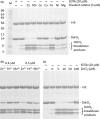Conservation and diversity of the IrrE/DdrO-controlled radiation response in radiation-resistant Deinococcus bacteria
- PMID: 28397370
- PMCID: PMC5552922
- DOI: 10.1002/mbo3.477
Conservation and diversity of the IrrE/DdrO-controlled radiation response in radiation-resistant Deinococcus bacteria
Abstract
The extreme radiation resistance of Deinococcus bacteria requires the radiation-stimulated cleavage of protein DdrO by a specific metalloprotease called IrrE. DdrO is the repressor of a predicted radiation/desiccation response (RDR) regulon, composed of radiation-induced genes having a conserved DNA motif (RDRM) in their promoter regions. Here, we showed that addition of zinc ions to purified apo-IrrE, and short exposure of Deinococcus cells to zinc ions, resulted in cleavage of DdrO in vitro and in vivo, respectively. Binding of IrrE to RDRM-containing DNA or interaction of IrrE with DNA-bound DdrO was not observed. The data are in line with IrrE being a zinc peptidase, and indicate that increased zinc availability, caused by oxidative stress, triggers the in vivo cleavage of DdrO unbound to DNA. Transcriptomics and proteomics of Deinococcus deserti confirmed the IrrE-dependent regulation of predicted RDR regulon genes and also revealed additional members of this regulon. Comparative analysis showed that the RDR regulon is largely well conserved in Deinococcus species, but also showed diversity in the regulon composition. Notably, several RDR genes with an important role in radiation resistance in Deinococcus radiodurans, for example pprA, are not conserved in some other radiation-resistant Deinococcus species.
Keywords: gene regulation; proteomics; regulon; transcriptional repressor; transcriptomics; zinc peptidase.
© 2017 The Authors. MicrobiologyOpen published by John Wiley & Sons Ltd.
Figures



Similar articles
-
DdrO is an essential protein that regulates the radiation desiccation response and the apoptotic-like cell death in the radioresistant Deinococcus radiodurans bacterium.Mol Microbiol. 2015 Jun;96(5):1069-84. doi: 10.1111/mmi.12991. Epub 2015 Apr 7. Mol Microbiol. 2015. PMID: 25754115
-
Radiation response in Deinococcus deserti: IrrE is a metalloprotease that cleaves repressor protein DdrO.Mol Microbiol. 2014 Oct;94(2):434-49. doi: 10.1111/mmi.12774. Epub 2014 Sep 18. Mol Microbiol. 2014. PMID: 25170972
-
New insights into the activation of Radiation Desiccation Response regulon in Deinococcus radiodurans.J Biosci. 2021;46:10. J Biosci. 2021. PMID: 33709962
-
Conservation and diversity of radiation and oxidative stress resistance mechanisms in Deinococcus species.FEMS Microbiol Rev. 2019 Jan 1;43(1):19-52. doi: 10.1093/femsre/fuy037. FEMS Microbiol Rev. 2019. PMID: 30339218 Free PMC article. Review.
-
Coexistence of SOS-Dependent and SOS-Independent Regulation of DNA Repair Genes in Radiation-Resistant Deinococcus Bacteria.Cells. 2021 Apr 16;10(4):924. doi: 10.3390/cells10040924. Cells. 2021. PMID: 33923690 Free PMC article. Review.
Cited by
-
The Deinococcus protease PprI senses DNA damage by directly interacting with single-stranded DNA.Nat Commun. 2024 Feb 29;15(1):1892. doi: 10.1038/s41467-024-46208-9. Nat Commun. 2024. PMID: 38424107 Free PMC article.
-
Structure and DNA damage-dependent derepression mechanism for the XRE family member DG-DdrO.Nucleic Acids Res. 2019 Oct 10;47(18):9925-9933. doi: 10.1093/nar/gkz720. Nucleic Acids Res. 2019. PMID: 31410466 Free PMC article.
-
Towards Exploring Toxin-Antitoxin Systems in Geobacillus: A Screen for Type II Toxin-Antitoxin System Families in a Thermophilic Genus.Int J Mol Sci. 2019 Nov 22;20(23):5869. doi: 10.3390/ijms20235869. Int J Mol Sci. 2019. PMID: 31771094 Free PMC article.
-
Characterization of the Radiation Desiccation Response Regulon of the Radioresistant Bacterium Deinococcus radiodurans by Integrative Genomic Analyses.Cells. 2021 Sep 25;10(10):2536. doi: 10.3390/cells10102536. Cells. 2021. PMID: 34685516 Free PMC article.
-
Structural and functional characterization of DdrC, a novel DNA damage-induced nucleoid associated protein involved in DNA compaction.Nucleic Acids Res. 2022 Jul 22;50(13):7680-7696. doi: 10.1093/nar/gkac563. Nucleic Acids Res. 2022. PMID: 35801857 Free PMC article.
References
-
- Bailey, T. L. , & Elkan, C. (1994). Fitting a mixture model by expectation maximization to discover motifs in biopolymers. Proceedings. International Conference on Intelligent Systems for Molecular Biology, 2, 28–36. - PubMed
-
- Baudet, M. , Ortet, P. , Gaillard, J. C. , Fernandez, B. , Guerin, P. , Enjalbal, C. , … Armengaud, J . (2010). Proteomics‐based refinement of Deinococcus deserti genome annotation reveals an unwonted use of non‐canonical translation initiation codons. Molecular & Cellular Proteomics: MCP, 9, 415–426. - PMC - PubMed
-
- Bouthier de la Tour, C. , Passot, F. M. , Toueille, M. , Mirabella, B. , Guerin, P. , Blanchard, L. , … Armengaud, J . (2013). Comparative proteomics reveals key proteins recruited at the nucleoid of Deinococcus after irradiation‐induced DNA damage. Proteomics, 13, 3457–3469. - PubMed
Publication types
MeSH terms
Substances
LinkOut - more resources
Full Text Sources
Other Literature Sources
Molecular Biology Databases

